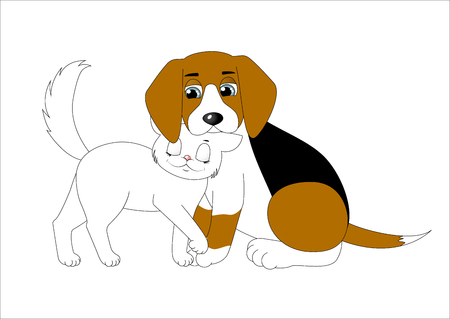1. Understanding the Importance of Nail Trimming
Keeping your dogs nails trimmed is more than just a cosmetic concern—its an essential part of their overall health and well-being. Long nails can cause discomfort, affect mobility, and even lead to serious health issues if left unchecked.
Why Regular Nail Trimming Matters
Many pet owners underestimate the impact that overgrown nails can have on their dogs. Here are some key reasons why keeping your pups nails at a proper length is crucial:
| Issue | How It Affects Your Dog |
|---|---|
| Pain and Discomfort | Nails that are too long press into the paw pads, causing pain when walking or standing. |
| Affects Mobility | Overgrown nails alter how your dog walks, leading to joint strain and posture problems. |
| Nail Breakage and Injury | Long nails are more likely to break or split, which can be painful and prone to infection. |
| Poor Traction | Your dog may struggle to walk on smooth surfaces, increasing the risk of slipping and falling. |
| Dew Claw Issues | If not trimmed, dew claws can curl into the skin, leading to pain and potential infections. |
The Right Nail Length for Your Dog
A good rule of thumb is that your dogs nails should not touch the ground when they are standing still. If you hear clicking sounds when they walk on hard surfaces, its time for a trim!
The Quick: Why You Should Trim Regularly
The “quick” is the sensitive inner part of the nail that contains nerves and blood vessels. If a dogs nails grow too long, the quick also extends, making it harder to trim them back to a healthy length without causing bleeding. Regular trimming helps keep the quick short, allowing for safer nail maintenance.
Avoiding Future Problems with Routine Care
Nail trimming should be part of your regular grooming routine. Getting your dog accustomed to the process from an early age can make future trims easier and less stressful for both of you.
2. Choosing the Right Tools for a Safe Trim
Picking the right nail trimming tool is essential to ensure a smooth and stress-free experience for both you and your dog. Different breeds and nail types require different tools, so its important to choose one that best fits your pup’s needs.
Types of Dog Nail Trimming Tools
There are two main types of nail trimming tools: clippers and grinders. Each has its own benefits, depending on your dogs size, temperament, and nail thickness.
Nail Clippers
Nail clippers are the most common tool for trimming dog nails. They come in two main styles:
| Clipper Type | Description | Best For |
|---|---|---|
| Guillotine Clippers | These have a hole where you place the nail, and a blade slides across to cut it. | Small to medium-sized dogs with thinner nails. |
| Scissor Clippers | Shaped like scissors, these provide more control and strength for cutting thicker nails. | Larger dogs or those with tough, thick nails. |
Nail Grinders
Nail grinders use a rotating sanding tool to gradually file down the nail instead of cutting it. They are great for shaping nails smoothly and reducing the risk of splitting or cracking.
Advantages of Nail Grinders:
- Smoother edges, reducing the chances of scratches.
- Easier to avoid cutting too much and hitting the quick.
- A good option for dogs who dislike clippers.
Selecting the Best Tool for Your Dog
The right tool depends on your dog’s breed, size, and comfort level with grooming. If your dog has thick nails or dislikes the pressure of clippers, a grinder may be a better choice. On the other hand, if your dog tolerates quick trims, clippers can get the job done faster.
![]()
3. Prepping Your Dog for a Stress-Free Experience
Before you start trimming your dogs nails, its important to create a calm and positive environment. Many dogs feel anxious about nail trimming, but with the right preparation, you can help them feel more comfortable.
Desensitizing Your Dog to Nail Trimming
Getting your dog used to nail trimming gradually can make the process much easier. Follow these steps to help desensitize your pup:
| Step | Description |
|---|---|
| 1. Introduce the Clippers or Grinder | Let your dog see and sniff the nail clippers or grinder without using them. Reward them with treats and praise. |
| 2. Touch Their Paws | Gently handle your dogs paws daily so they become comfortable with the sensation. |
| 3. Simulate the Trimming Process | Pretend to trim their nails by tapping the clippers against their nails without cutting. Give treats to create a positive association. |
| 4. Trim One Nail at a Time | Start with just one nail per session to keep stress levels low. Gradually increase as they become more comfortable. |
Creating a Calm Environment
The right setting can make a big difference in how your dog reacts to nail trimming. Here’s how you can create a peaceful environment:
- Pick a Quiet Space: Choose a room with minimal distractions and noise.
- Use Positive Reinforcement: Have treats ready to reward good behavior throughout the process.
- Keep Sessions Short: If your dog is nervous, keep trimming sessions brief and stop before they get too stressed.
- Play Calming Music: Soft background music or white noise can help relax your dog.
- Trim After Exercise: A tired dog is often more cooperative, so consider trimming their nails after a walk or playtime.
Building Trust and Patience
Nail trimming should never be rushed. Take your time, be patient, and always use positive reinforcement to build trust with your dog. With consistent practice and a calm approach, your dog will eventually learn that nail trims are nothing to fear.
4. Step-by-Step Guide to Trimming Your Dogs Nails
Follow a simple, stress-free process for trimming your dogs nails safely, including how to avoid cutting the quick. With patience and the right technique, nail trimming can be an easy and positive experience for both you and your dog.
Step 1: Gather Your Supplies
Before you begin, make sure you have everything you need:
| Item | Purpose |
|---|---|
| Dog Nail Clippers or Grinder | For trimming nails safely |
| Styptic Powder or Cornstarch | To stop bleeding if you cut the quick |
| Treats | For positive reinforcement |
| A Calm Environment | To reduce stress for your dog |
| A Towel or Blanket (Optional) | If your dog needs extra comfort or restraint |
Step 2: Help Your Dog Relax
Your dog should be calm before you start. Try these tips:
- Tire them out: A walk or play session beforehand can help.
- Create a peaceful environment: Trim in a quiet space without distractions.
- Praise and reward: Give treats and gentle pets to keep them comfortable.
Step 3: Identify the Quick
The quick is the sensitive part of the nail that contains blood vessels. Cutting it can cause pain and bleeding. Here’s how to identify it:
- If your dog has light-colored nails: The quick appears as a pink area inside the nail.
- If your dog has dark-colored nails: Trim small amounts at a time, looking for a darker circle in the center of the nail—this indicates youre getting close to the quick.
Step 4: Start Trimming Slowly
Began by holding your dog’s paw gently but firmly. Use these steps:
- Select a single nail: Focus on one nail at a time.
- Cut small amounts: Trim little by little rather than taking off too much at once.
- Avoid cutting too close to the quick: Stop when you see a change in texture or color inside the nail.
- If using a grinder: Smooth edges gently in short bursts to prevent heat buildup.
Step 5: Reward and Repeat
Praise your dog after each trimmed nail with treats or verbal encouragement. If they seem stressed, take breaks as needed. Over time, they’ll associate nail trimming with positive experiences.
Troubleshooting Common Issues
| Issue | Solution |
|---|---|
| Your dog pulls away or resists. | Takes breaks, offer treats, and go slow to build trust. |
| You accidentally cut the quick. | Dab styptic powder on the nail to stop bleeding and comfort your dog. |
| Your dog is afraid of clippers. | Slowly introduce them by letting your dog sniff and hear them before trimming. |
| The nails are very long. | Trim small amounts every few days until they reach a safe length. |
Avoiding Future Nail Trimming Stress
- Create a routine: Regular trims help keep nails short and prevent anxiety.
- Treats and praise: Always make it a rewarding experience.
- If needed, seek professional help: A groomer or vet can assist if trimming is too stressful for your dog.
Nail trimming doesn’t have to be stressful! By following these steps, you’ll keep your pup’s paws healthy while making the process easier for both of you.
5. Dealing with Accidents and Keeping Your Dog Comfortable
Even with the most careful trimming, accidents can happen. If you accidentally cut the quick, it may cause bleeding and discomfort for your dog. The key is to stay calm and act quickly to minimize stress for both you and your pet.
What to Do If You Cut the Quick
If you notice bleeding after trimming a nail too short, follow these steps:
| Step | Action |
|---|---|
| 1 | Stay calm and reassure your dog with a gentle voice. |
| 2 | Apply styptic powder or cornstarch to the bleeding nail using a cotton swab. |
| 3 | Apply gentle pressure for a few seconds until the bleeding stops. |
| 4 | If bleeding continues after several minutes, contact your vet for advice. |
| 5 | Give your dog a treat and some extra affection to help them relax. |
How to Keep Your Dog Comfortable During and After Trimming
Your dog may become anxious or fearful after an accident. To make future nail trims easier, focus on keeping them comfortable:
- Create Positive Associations: Offer treats and praise before, during, and after trimming sessions.
- Use Distractions: Give your dog a chew toy or peanut butter spread on a lick mat to keep them occupied.
- Avoid Rushing: If your dog seems stressed, take breaks between nails instead of doing all at once.
- Praise Calm Behavior: Reward your dog when they remain calm to reinforce positive experiences.
When to Seek Professional Help
If your dog consistently struggles with nail trims or has had multiple bad experiences, consider seeking help from a professional groomer or veterinarian. They can provide guidance and even demonstrate techniques to make the process smoother for both you and your pet.


